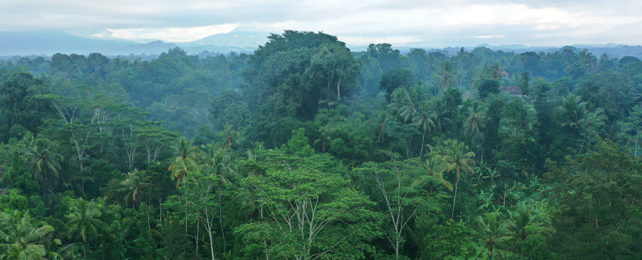The devastating destruction that's happening across the Amazon might be what comes to your mind first when thinking about deforestation – but it's by no means the only place where dwindling forests are a worry, as a new study highlights.
It's the first study to comprehensively examine the amount of forest lost to intensive industrial mining activities in the tropics, and it's not pretty. Some 3,264 square kilometers (1,260 square miles) of tropical forest was lost due to mining between 2000 and 2019, the researchers found – greater than the area of Yosemite National Park.
Satellite data showed four-fifths of this deforestation happened in just four countries: Indonesia, Brazil, Ghana, and Suriname. Indonesia was at the top of the table, solely responsible for 58.2 percent of the recorded tropical deforestation directly caused by the expansion of industrial mines.
"There is a broad range of environmental damage caused by mining operations on top of deforestation, including destruction of ecosystems, loss of biodiversity, disruption of water sources, the production of hazardous waste and pollution," says Stefan Giljum, an associate professor at the Institute for Ecological Economics at the Vienna University of Economics and Business in Austria.
"Government permitting should take all of this into account: an industrial mine can easily disrupt both landscapes and ecosystems. Industrial mining remains a hidden weakness in their strategies to minimize environmental impacts."
The study data covered a total of 26 different countries, accounting for 76.7 percent of the total mining-related tropical deforestation that happened between 2000 and 2019. These mining activities covered coal, gold, iron ore and bauxite extraction.
The consequences of mining stretched far beyond the extraction of resources. In two-thirds of tropical countries, deforestation within 50 kilometers (about 30 miles) of mines resulted from factors such as transport infrastructure, storage facilities, and the growth of townships.
If there is any good news, it's that the level of deforestation due to mining is now falling. Indonesia, Brazil and Ghana all saw forest loss due to industrial mining peak between 2010 and 2014, though coal mining specifically continues to grow in Indonesia.
"Although Indonesia's total deforestation has declined annually since 2015, these findings emphasize the continued need for strong land use planning to ensure mining does not destroy forests or violate community rights," says Hariadi Kartodihardjo, a professor of Forest Policy at Bogor Agricultural University in Indonesia.
The researchers note that the current political situations in countries such as Brazil and Indonesia mean that a major reduction in mining and deforestation is unlikely in the near future – they're calling on industry groups and conservation organizations to take the lead in reducing the level of damage.
They also point out that in some tropical countries, other land-intensive activities, such as cattle farming or palm oil and soybean production, cause more deforestation than mining does.
As previous research has shown, one of the best ways to prevent deforestation is to recognize and enforce the property rights of local communities and indigenous peoples who have been living in the forests long before the mining companies arrived.
In future studies, the researchers want to look at smaller scale and artisanal mining operations that sometimes fly under the radar when it comes to an environmental analysis like this. Ultimately the aim is to get a better understanding of what's happening – and then take action.
"Against the rapidly growing demands for minerals, in particular for metals for renewable energy and e-mobility technologies, government and industry policies must take into account both the direct and indirect impacts of extraction," says geographer Anthony Bebbington of Clark University in Massachusetts.
"Addressing these impacts is an important tool for conserving tropical forests and protecting the livelihoods of communities who live in these forests."
The research has been published in PNAS.
